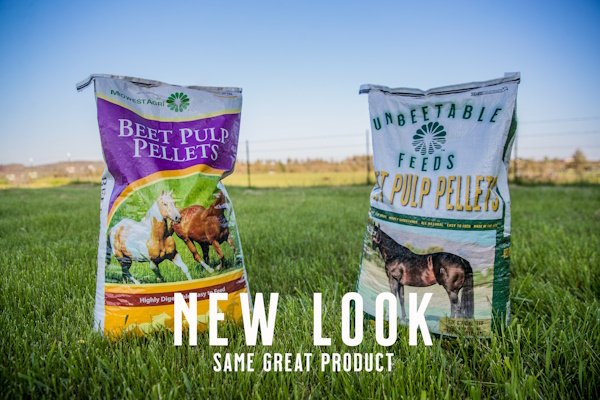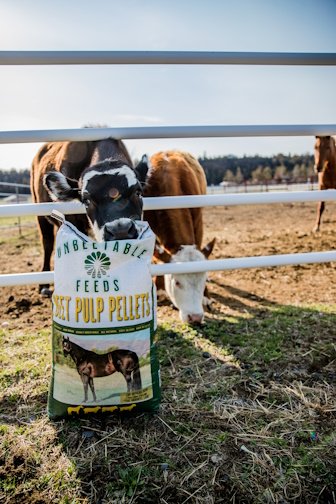Beet Pulp Pellets
Beet pulp is the fibrous portion of the sugar beet, left after the sugar and liquid has been removed. It is mechanically pressed, dried, and then pelletized into a 5/16” (8mm) diameter pellet. The fiber in beet pulp is highly digestible making it a good non-starch energy source for cattle and horses. It is a popular feed used by dairy farmers as a structural carbohydrate, and is also widely used as an ingredient in the production of pet foods.
Midwest Agri markets beet pulp pellets throughout the world. Asia and European markets represent our largest export outlets.
Midwest Agri offers beet pulp pellets in bulk, or in Unbeetable Feeds 50-pound bags. The 50-pound bags are more convenient to handle, making it a favorite at feed stores. The bags, shipped on pallets, allows a manageable package of feed for smaller ranches or farms that raise horses, cattle or other farm animals.
UNBEETABLE FEEDS Bagged Beet Pulp Pellets:
Individual bags for sale at local retail feed stores. Click on store locator to find a store near you.
Local pick up: bagged pellets – full pallets only (40 bags, 2,000 lbs)
Truck (FOB or Delivered): Bagged pellets (22 short tons, 22 pallets, 880 bags)
Bulk Beet Pulp Pellets:
Local pick up
Truck (FOB or Delivered) – Approximately 25 short tons
Railcar – Approximately 90 short tons
Vessel and Ocean Containers (export customers only) – Please contact our sales department
USES
In growing and finishing diets, beet pulp pellets can replace corn silage or other forages.
For stock cows, it can fill energy requirements and stretch homegrown forage supplies. In dairy rations, beet pulp is an excellent source of structural carbohydrates, lowers the potential for rumen acidosis and improves butter-fat test. It is also a high-energy, easy-to-digest food that helps to stimulate milk production.
In pet food, beet pulp is used as lower tract cleanser as well as stool firmer. It is an excellent source of fermentable fiber.
Please consult your nutritionist for uses specific to your animals.
STORAGE AND HANDLING
Beet Pulp Pellets can be stored by unloading on a cement slab, preferably covered, or they can be stored in conventional hopper bottom bins. They can be transferred in hopper, end-dump or live bottom trucks. Feeding and handling will depend on the method of storing and the feeding systems available but they can be easily handled in traditional automated systems or front-end loader mixer wagon combinations.
TYPICAL ANALYSIS
Variation may occur depending on source.
For below information in PDF form, please download here.
Analyte |
Dry Basis |
As Fed |
| Dry Matter | 90.73% | |
| Moisture | 9.27% | |
| Protein, Crude | 8.29% | 7.52% |
| Fiber, Crude | 16.97% | 15.42% |
| ADF - Acid Detergent Fiber | 26.68% | 24.22% |
| NEL - Net Energy Lactation | 0.72 Mcal/lb | 0.65 Mcal/lb |
| NEG - Net Energy Gain | 0.46 Mcal/lb | 0.41 Mcal/lb |
| NEM - Net Energy Maintenance | 0.78 | 0.71 Mcal/lb |
| TDN - Total Digestible Nutrients | 69.40% | 63.04% |
| Fat | 1.09% | 1.00% |
| Ash | 7.56% | 6.86% |
| NFE - Nitrogen Free Extract | 66.09% | 60.03% |
| Calcium | 1.00% | 0.91% |
| Phosphorus | 0.07% | 0.06% |
| Potassium | 0.56% | 0.51% |
| Reducing Sugars | 2.60% | 2.39% |
| Sucrose | 8.96% | 8.15% |
| TSI - Total Sugars as Invert | 8.23% | 7.43% |
Random Fact:
The principal fibers in beet pulp are cellulose, hemicellulose and pectin. It is very low in indigestible lignin, making it one of the most effective fibers available.
Domestic:
Bulk Pulp Sales:
Matt Steinmetz
(612) 790-4187
msteinmetz@mwagri.com
Unbeetable Feeds Bagged Pulp Sales:
Jason Stewart
(541)910-6975
jstewart@mwagri.com
Export Pulp Sales:
Bryan Edwardson
(415) 259-2629
bedwards@mwagri.com







